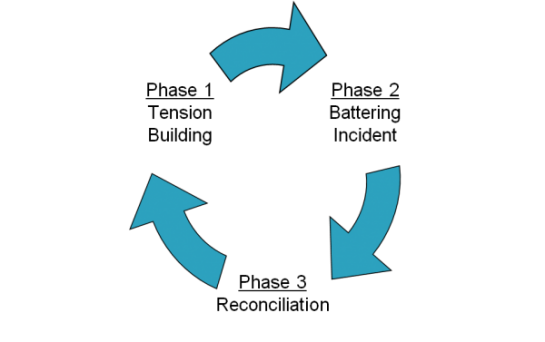Perpetrators of Domestic Violence
Domestic violence is defined as, “One individual systematically abusing another to gain power or control in a domestic or intimate relationship.” In relationships where domestic violence occurs, instead of both partners being equal in the relationship, the balance of power is uneven and the perpetrator tries to maintain control over the victim.
Abusive partners use a variety of tactics to exert power and control over their victims. They may use any, a combination of, or all of the following forms of abuse:
- Emotional, Verbal or Psychological Abuse: name-calling, put-downs, humiliation, jealousy, mind games, making the victim feel crazy, making the victim feel bad about her/himself, making the victim feel as though they are to blame, and comments such as “No one will ever love you as much as I do,” “No one will ever believe you,” and “You’re so stupid, fat,” etc.
- Financial Abuse: the perpetrator uses money as a way to control their partner or to keep the victim from leaving, such as not letting them work, taking their paycheck, forcing them to take high rate installment loans for bad credit, giving them an “allowance” (or not allowing them to control their own income), counting their receipts, not allowing them to establish their own credit and withholding financial information from them, among others.
- Spiritual or Cultural Abuse: denying the victim the right to practice their religion or to pursue religious, spiritual or cultural activities, belittling the victim’s religious beliefs, or stating that certain forms of abuse are justified as a cultural tradition or as acts supported by religious beliefs.
- Sexual Abuse: any unwanted touching or kissing, forcing or demanding sex, forcing unprotected sex, coercion and manipulation of sex (“if you don’t have sex with me, I will….”).
- Physical Abuse: shoving, hitting, kicking, slapping, punching, pinching, grabbing, hair pulling, biting, strangling, or intimidating the victim with threats of physical abuse (such as throwing objects, or punching walls).
Often, an abusive partner will begin by using emotional or psychological abuse (such as name-calling or putting the victim down), and then escalate to other forms of abuse, such as physical violence. Typically, the violence starts off more subtle and then grows in frequency and severity.
The cycle of abuse involves three phases, including:
- Tension-Building Phase: this phase is characterized by the victim sensing tension and fearing an outburst. During this stage, the victim tries to calm the abuser down and may “walk on eggshells” to avoid any major violent confrontations.
- Violent Episode: this phase is characterized by outbursts of violent, abusive incidents by the perpetrator. During this stage, the abuser attempts to dominate his/her partner with the use of violence. This phase may include physical or other types of abuse.
- Reconciliation: this phase is characterized by the abusive partner showing affection or offering an apology, with the appearance of an “end” to the violence. During this stage, the perpetrator shows overwhelming feelings of remorse and sadness. Some abusers walk away from the situation, while others shower their victims with love and affection.
However, the violence does not end here. The cycle then repeats, over and over.
It is a common misconception that perpetrators just “lost control” when they emotionally or physically abuse their partners. However, this is not true. Domestic violence is the exact opposite of losing control; perpetrators know what they are doing and use their abusive tactics of choice to maintain dominance in the relationship.
Some common statements abusers may use to excuse or minimize the violence they perpetrate against their partners include:
- “It wasn’t me, it was the alcohol/drugs”, etc.
- “You made me do it”, “You know how to push my buttons” or “You know how to get me going”
- “I didn’t mean it”
- “I just lost control”
- “I won’t do it again”
Why Batterer’s Intervention?
Often, batterers have learned their violent behavior by witnessing or being exposed to domestic violence during their formative years.
The good news is, because domestic violence is a learned behavior, it can also be “un-learned”. With appropriate accountability measures and self awareness tools, abusive partners can go on to have healthy, respectful relationships if they accept responsibility for their actions, identify and challenge the belief systems which contributed to their unhealthy behaviors and learn healthy, non-violent ways to interact with their partners.
Because a perpetrator’s abusive behavior has often been learned over a period of many years, it can take a significant amount of time to change. As compared to Anger Management programs, Batterer’s Intervention is a much lengthier (minimum of 40 weeks) and comprehensive program which:
- Holds individuals accountable for their abusive behaviors and choices
- Addresses the root causes and belief systems which contributed to the violent behaviors
- Challenges perpetrators to recognize and adjust their abusive behaviors and attitudes, with the goal of preventing violence in their current and future relationships.
To learn more about New Hope’s Department of Public Health-certified RESPECT Batterer’s Intervention Program, click here.

